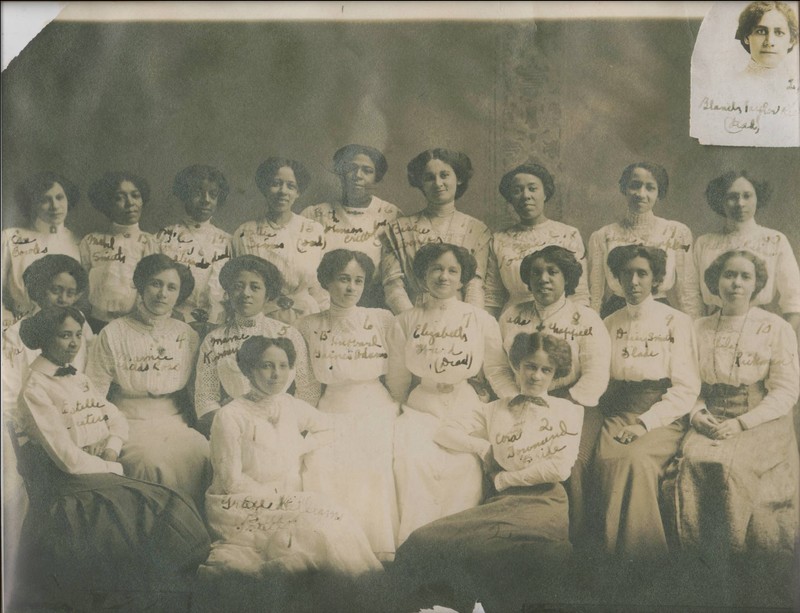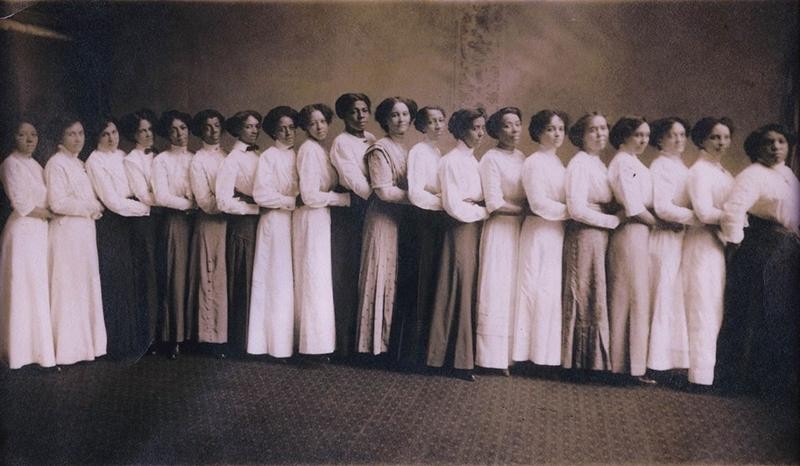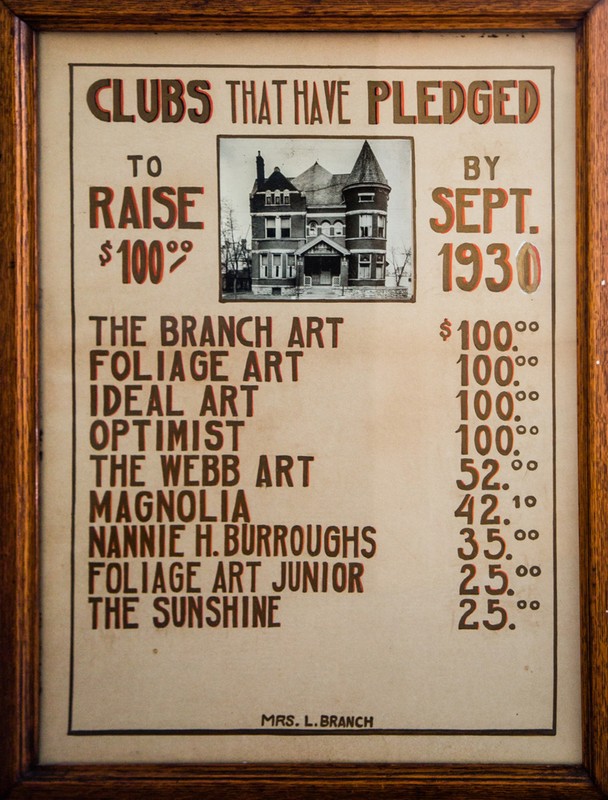Cincinnati Federation of Colored Women's Clubs
Introduction
Text-to-speech Audio
Images
Members of the Cincinnati Federation of Colored Women's Clubs. Date unknown, but likely taken in the 1910's.

Members of the Cincinnati Federation of Colored Women's Clubs. Date unknown, but likely taken in the 1910's.

The CFCWC Clubhouse on 1010 Chapel St.

CFCWC clubs fundraise toward mortgage payments on the clubhouse amidst the Great Depression

Backstory and Context
Text-to-speech Audio
Overview of the Cincinnati Federation of Colored Women's Clubs
In 1904, eight local Black women’s organizations across Cincinnati came together to form the Cincinnati Federation of Colored Women’s Clubs (CFCWC). Their stated purpose was for “the betterment of the community and the race at large, by bringing together the various clubs for unity and action and exchange of ideas in the furthering of race progress." The CFCWC soon blossomed into a vibrant organization composed of dozens of clubs and more than 1,000 members throughout the 20th century. Their activities aimed to uplift their community through cooperation, mutual aid, and community service. In 1924, the CFCWC purchased a Samuel Hannaford mansion located in the Cincinnati neighborhood of Walnut Hills. The building has been utilized as the CFCWC’s clubhouse ever since and continues to be the organization’s regular meeting space.
CFCWC in the context of national Black women organizing
Historians have argued that since the days of slavery, African Americans have engaged in voluntary associations, indicating “a historical legacy of collective consciousness and mutual associations.” Historian Leonard Curry conservatively estimates that by the year 1850, there were over 200 Black mutual aid societies constituted by 13,000-15,000 members in major northern U.S. cities. These figures suggest that such mutual associations among Black people took on a formal structure even before the abolition of slavery. Another scholar, Stephanie Shaw, argues that the abolition of slavery allowed community organizing to further formalize their structures of organization. Black organizations furthermore became national in scope into the 20th century through the Great Migration, as migrants maintained contact with friends and kin who remained in the South or traveled to different cities across Northern states. African American woman consistently took an active role in organizing local mutual aid societies and connecting them across the nation.
Cincinnati was a destination for many migrants traveling from the South as part of the Great Migration, which was a widespread pattern of migration by African Americans from the rural south to northern cities that took place between 1916 and 1970 in the U.S. The CFCWC is but one example of a mutual organization which arose out of a long-held spirit of community consciousness among African Americans, and had national ties with other similar organizations through their membership in the National Association of Colored Women’s Clubs.
CFCWC Community service and mutual aid
Below is a list of projects by the CFCWC since its inception.
- Establishing Mother’s Clubs and kindergartens to alleviate the workload of working mothers. One of the CFCWC’s first projects was to support the creation of a free kindergarten at Brown Chapel A.M.E. Church in Walnut Hills to help working mothers. The project was very successful and eventually the school became part of the city’s public school system.
- Aiding and supporting children implicated in the juvenile court system. An early project provided aid to children under jurisdiction of the Juvenile Court. The club aimed to de-stigmatize the status of being a juvenile offender “to give them a chance to live as deserving children”— work that was eventually also taken up by the City of Cincinnati.
- Supporting African American southern migrants who moved to Cincinnati in the Great Migration. The CFCWC clubhouse served as a temporary home to many young Black women and families who arrived in Cincinnati as they migrated from the South.
- Raising money for the Home for Aged Colored Women, Longview Hospital, and Cincinnati’s Colored Orphanage. Members have regularly crowdsourced funds for various local social institutions. For example, in the early part of the 20th century, members donated $150 each to maintain the Home for Aged Colored Women building located at 2918 Park Ave. Members later donated $50 each to help move the home to 1334 ½ Lincoln Ave. The CFCWC maintained close ties with the Home, with many members becoming residents themselves at the end of their lives.
- Awarding higher education scholarships to members of the community.
CFCWC Clubhouse
In 1924, the CFCWC purchased a mansion in Walnut Hills to serve as their clubhouse. The house was built by architect Samuel Hannaford in 1888 for C. H. Burroughs, and was listed on the National Registry of Historic Places in 1980. It is a 2 1/2 story brick building with Romanesque and Queen Anne stylistic influences.
Before purchasing the building, members of the CFCWC met in churches and homes around the neighborhood and city. According to the club’s history, the property was purchased in order to be used as a temporary home for “young women, strangers who came to Cincinnati seeking work.” The first floor was used for internal club meetings and public meetings.The CFCWC’s historian occupied the second floor for a number of years. Rooms on the third floor were rented to migrants, many of whom were migrating north as part of the Great Migration.
Over more than 20 years, the CFCWC actively fundraised to pay off the mortgage and kept current on payments even through the Great Depression. They held weekly benefit shows to cover the initial down payment and subsequent monthly payments. In addition, individual member clubs organized their own fundraisers to contribute to the mortgage fund, and coordinated drives to furnish the building. The cost of the house was paid off in full in the year 1946, and a Thanksgiving Service was held in honor of this achievement, full of speeches, prayer, and song.
Sources
1. “Articles of Confederation of the Cincinnati Federation of Colored Women’s Clubs.” State of Ohio Office of the Secretary of State, Columbus, OH, April 16, 1915. PDF file. 20 November 2019. https://digital.cincinnatilibrary.org/digital/collection/p16998coll77/id/71/rec/3
2. “Cincinnati Federation of Colored Women’s Clubs.” www.WalnutHillsStories.com. Walnut Hills Historical Society, Cincinnati, OH. Accessed 3 May 2020. http://www.walnuthillsstories.org/stories/womens-history-fact-cincinnati-federation-of-colored-womens-clubs/
3. Curry, Leonard P. The Free Black in Urban America, 1800-1850. Chicago: University of Chicago Press, 198. Print.
4. Gordon, Stephen C. and Elisabeth H. Tuttle. “Buildings and Structures in Hamilton County, Ohio Designed by Samuel Hannaford/Samuel Hannaford & Sons; 1858-1900.” National Register of Historic Places Inventory/Nomination Form. Miami Purchase Association for Historic Preservation, Cincinnati, OH, December 11, 1978. PDF file. Accessed 16 January 2020. http://cincinnatipreservation.org/wp-content/uploads/2018/01/Hannaford-NR-nomination-64000626-1.pdf
5. Heyne, Mark. “Historic Gathering: Reviving a Clubhouse for Women with the Help of Friends.” WVXU.org. Cincinnati Edition, Cincinnati, OH, February 14, 2018. Accessed 3 May 2020. https://www.wvxu.org/post/historic-gathering-reviving-clubhouse-women-help-friends#stream/0
6. Moran, Virginia; Lulu O. McClure; Carolyn Broach; Edith Rollins; Geraldine Thornton. Additional History of the Cincinnati Federation of Colored Women’s Clubs (September 1952-June 1961). Cincinnati Federation of Colored Women’s Clubs, Cincinnati, OH, June 1961. PDF file.
7. Ohio. Hamilton County. 1920 U.S. Census, population schedule, enumeration district 56, sheet 13A. National Archives and Records Administration, Washington, DC. PDF file.
8. Ohio. Hamilton County. 1930 U.S. Census, population schedule, enumeration district 31-82, sheet 12A. National Archives and Records Administration, Washington, DC. PDF file.
9. Shaw, Stephanie. “Black Club Women and the Creation of the National Association of Colored Women.” Journal of Women’s History, Volume 3, Number Two, Fall 1991, pp. 11-25. John Hopkins University Press, 1991.
10. Slade, Grace and Bertha Saunders. History of the Cincinnati Federation of Colored Women’s Clubs (1904-1952). Cincinnati Federation of Colored Women’s Clubs, Cincinnati, Ohio, 1952. PDF file.
Cincinnati Federation of Colored Women's Clubs Collection. Cincinnati Public Library, Digital Library.
Provided by the CFCWC; via WVXU.org
Hailey Bollinger, CityBeat.com
Provided by the CFCWC; via CityBeat.com
